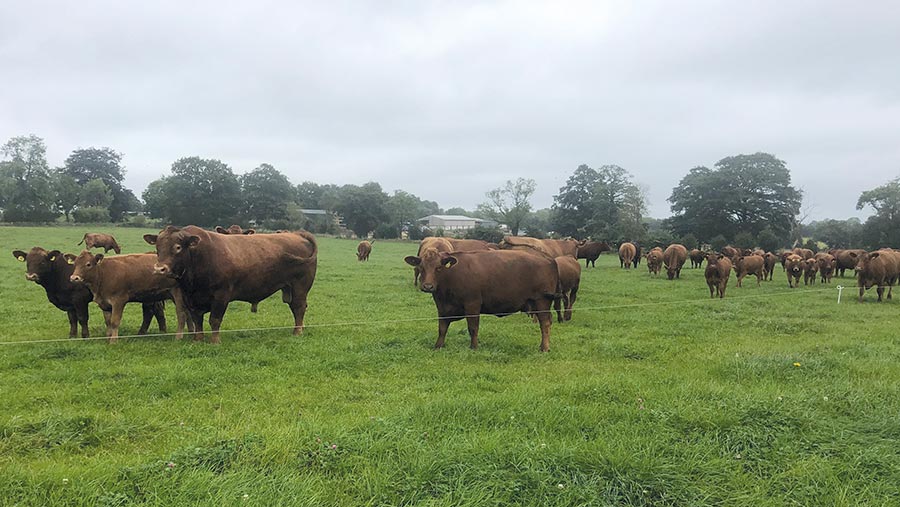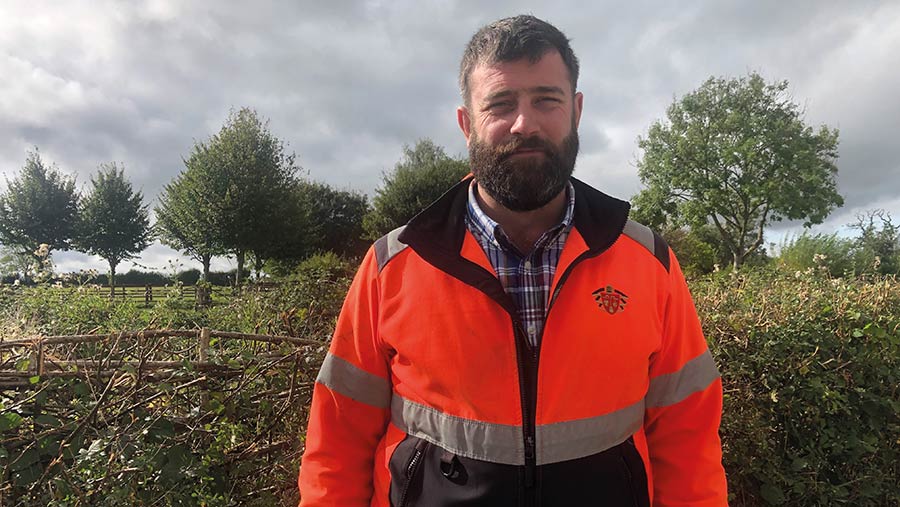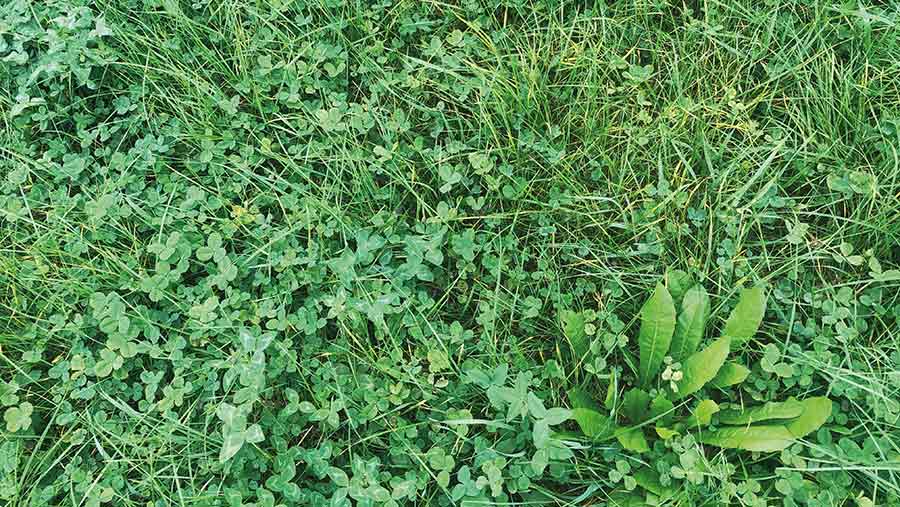Integrating beef unit on arable land – do costs add up?
 © MAG/Emma Gillbard
© MAG/Emma Gillbard Peter Lord, farm manager at Norwood Farm, near Bath teamed up with the AHDB and Adas to convert the 290ha long-term arable farm into an integrated mixed farming enterprise.
He was motivated by an AHDB project investigating the benefits of sustainable beef systems across arable land – hosted by Dyson farming – which has seen significant improvements to soil condition, cereal yield, worm counts, and even net margin.
For arable farmers, the establishment of grass leys associated with beef herds provides an opportunity to extend their rotation, while also diversifying income streams.
See also: Variety verdict: Top-performing wheats and barleys of 2021
We look at how Mr Lord went about the integration, the costs and the margins, to see if it makes economic sense.
Farm facts
- Hinton Estate 1,520ha, including the 290ha Norwood Farm
- Cropping includes: Winter wheat, winter barley, forage maize, winter beans and spring barley. Typically at Norwood- temporary grass in to wholecrop winter triticale.
- Average wheat yields: 9-10t/ha
Integrating livestock
After Dyson Farming first took on Norwood Farm in 2015, which forms part of the 1520ha Hinton Estate within Dyson Farming, the majority of land had been planted to winter wheat for the previous 12 years.
To make the most of his background in livestock, Mr Lord decided to bring beef cattle on farm to try to tackle blackgrass issues and improve soil health, alongside a sheep flock of 1,300 ewes.
The ultimate aim was to create a sustainable and profitable beef unit within the arable rotation and promote farm resilience. But being new to the farm, Mr Lord admits this was sometimes a challenge.
“With the help from the AHDB and Adas, we formed the research programme and started our journey. Now in our fifth and final season of the trial, hopefully we have the answers to some of the questions we started with.
“Our initial focus was controlling blackgrass and selecting grass leys for optimum livestock growth, but we also discovered so much about the improvements grass brought to soil friability, structure and organic matter,” says Mr Lord.

Farm manager Peter Lord © MAG/Emma Gillbard
Research project
The project involved a block of six fields, totalling 35ha of either a grass and clover ley or a mixed grass and herbal ley, established in autumn 2017.
The clover mix was composed of both intermediate and late heading perennial rye grass, 1kg/ha medium leaf white clover and 1kg/ha of timothy.
The herbal ley contained perennial rye grass, both red and white clover, timothy, birds foot trefoil, plantane, chicory, parsley and yarrow.
Each field was then rotationally grazed using a grazing platform to feed a proportion of the farm’s 200 head of stabiliser cattle, at a stocking rate of 4.3/ha.
Adas principal soil scientist Lizzie Sagoo, who worked on the project, explains how baseline soil samples were taken prior to grass establishment.
“Soils were already in a reasonably good condition before we started the project, which made finding any potential differences more challenging,” says Dr Sagoo.
Despite this, statistically significant improvements in soil organic matter were found after the five years with a 0.3% uplift from 7.8% to 8.1%.
“This is the equivalent of an additional 6t/ha of organic matter found in the top 15cm of the soil profile,” she says.
A 60% increase in earthworm populations was also reported.
Furthermore, a split field trial investigating the yield of spring barley following a grass clover ley reported a yield improvement of 0.7t/ha.
The spring barley crop was drilled after a three-year grass clover ley which was sprayed off, ploughed and then power harrow drilled, before finally being harvested on 2 September.

© MAG/Emma Gillbard
Grass and arable
Initially, Mr Lord had the intention of removing the grass leys after three years and bringing them back into the arable rotation. However, performance from most of the leys held up, prompting him to keep them for a further two years.
“There is no guarantee that we will bring these fields back into arable. Instead, we may rejuvenate the grass leys and keep them in grass as the stabiliser beef animals are performing well off of them.
“We have one grass block which is not performing so well, which has now been sprayed off and will be planted to whole crop winter triticale,” he says.
Not only have the grass leys improved soil structure, drainage and helped promote arable yields, but they provide an opportunity to diversify the farm’s rotation.
On the Cotswold brash land away from Norwood, winter wheat, winter barley, forage maize, winter beans and spring barley is grown, with the winter barley, beans and maize fed to the beef herd.
For the first time this winter, Mr Lord has the option to outwinter some spring calving cows on a summer-sown brassica crop across the farm’s sandy soils.
Beef animals also provide valuable farmyard manure which is applied to arable land, where required, helping cut artificial fertiliser inputs. Clover leys also have the ability to fix 150kg N/ha, reducing fertiliser requirements for the potential following cereal crop.
Economics – do the figures add up?
For beef units to be set up on arable farms the economics have to add up. We take a closer look at the costs and margins associated with the beef unit at Norwood Farm.
A planned economic analysis of integrating beef and grass leys was carried out to establish whether the enterprise:
- Acted as a viable alternative income source
- Had margins equal or better than that of crop margins per hectare
- Demonstrated a positive impact on arable yields
- Reduced inputs.
Dyson farming already owned the farm and cattle, so a list of set-up, variable and overhead costs were costed and calculated by the AHDB to generate a net margin.
Mark Topliff, lead analyst in farm economics at the AHDB, explains the economics of integrating beef onto the farm and notes its ability to achieve the same or higher net margin per hectare, compared with traditional arable cropping.
“The net margin of £227/ha for the grass clover ley and £274/ha for the herbal ley competes well with the net margins of conventional cropping. In fact, it outperforms most arable crops with the exception of winter wheat,” he says.
It is worth noting that any potential yield benefits from following cereal crops and potential savings in fertiliser costs as a result of using livestock manures and use of clover leys have not been accounted for, but this is something the farm intends to do in time.
Set-up costs |
||
|
Ley establishment |
Grass clover ley (£/ha) |
Grass herbal ley (£/ha) |
|
Subsoiling, power harrowing, drilling and rolling |
113 |
113 |
|
Seed cost |
178 |
205 |
|
Total |
291 |
318 |
|
Infrastructure |
Grass clover ley (£/ha) |
Grass herbal ley (£/ha) |
|
|
Fencing, gates, water troughs, pipes, cattle crush |
603 |
603 |
|
|
Labour |
417 |
417 |
|
|
Total |
1,020 |
1,020 |
|
Cattle variable and overhead costs |
||
|
Variable costs |
Grass clover ley (£/ha) |
Grass herbal ley (£/ha) |
|
Supplementary feed, fertiliser and sprays |
171 |
145 |
|
Vet and meds |
16. 6 |
16. 6 |
|
Total |
187.6 |
161. 6 |
|
Overhead costs |
Grass clover ley (£/ha) |
Grass herbal ley (£/ha) |
|
Labour – cattle |
150 |
150 |
|
Fertiliser spreading |
15 |
15 |
|
Electricity, fuel and water |
46 |
46 |
|
Total |
211 |
211 |
|
Total rearing costs £/head |
93 |
87 |
Estimated margin at Norwood Farm |
||
|
|
Grass clover ley |
Grass herbal ley |
|
Cattle output |
£184/head |
£191/head |
|
Cattle output |
£791/ha |
£821/ha |
|
Set up costs lay and infrastructure costs |
£165/ha |
£174/ha |
|
Rearing costs of cattle |
£399/ha |
£373/ha |
|
Net margin before rent and finance |
£227/ha |
£274/ha |
|
Source: All figures were costed and calculated by AHDB and not Dyson farming data |
||
Net margin for arable cropping in South West |
|
|
Crops |
Net margin (£/ha) |
|
Winter wheat |
567 |
|
Winter barley |
222 |
|
Spring oats |
198 |
|
Spring barley |
180 |
|
Winter oilseed rape |
101 |
|
Winter beans |
27 |
|
Spring linseed |
-293 |
|
Source: AHDB Farmbench South West farms on clay loam and silty clay loam soils. Three-year average taken between 2018-20, before rent and finance |
|

